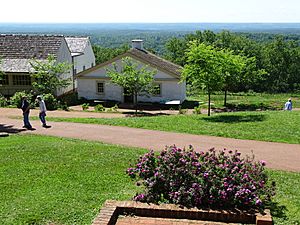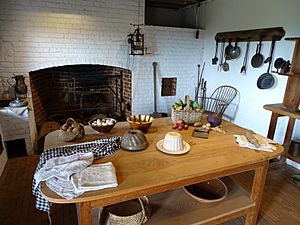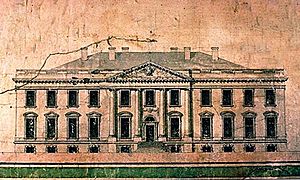Edith Hern Fossett facts for kids
Quick facts for kids
Edith Hern Fossett
|
|
|---|---|
| Born |
Edith Hern
1787 |
| Died | 1854 (aged 66–67) |
| Resting place | Union Baptist Cemetery, Cincinnati, Ohio |
| Education | Honoré Julien, French chef |
| Occupation | Enslaved cook for Thomas Jefferson at President's House (White House) and head cook at Monticello |
| Spouse(s) | Joseph Fossett |
| Children | 10, including Peter Fossett |
| Relatives | Mary Hemings (mother-in-law) James Monroe Trotter (grandson-in-law) William Monroe Trotter (great-grandson) Pauline Powell Burns (great-granddaughter) |
Edith Hern Fossett (1787–1854) was an amazing African American chef. For most of her life, she was enslaved by Thomas Jefferson. Later, she gained her freedom. Her family, the Herns, worked for three generations on Jefferson's land. They worked in fields, managed the household, made tools, and cared for children. As a girl, Edith helped care for Harriet Hemings, a daughter of Sally Hemings, at Jefferson's Monticello home.
In 1802, Edith worked as a cook for President Jefferson. She worked at the President's House, now known as the White House. Her sister-in-law, Fanny Gillette Hern, worked with her. They learned to cook fancy French food from a French chef named Honoré Julien. Edith had three children with Joseph Fossett while working there. They stayed with her until 1809, when Jefferson's second term ended. She did not get a salary, but she earned a small tip of two dollars each month.
When Edith returned to Monticello, she became the main cook. She used a very modern kitchen for her time. It had special burners that could be controlled individually. She used many copper pans and a good clock for timing her cooking. Her ingredients were always fresh from the plantation's fields. Every day, she made wonderful meals with many different dishes. These meals were for 12 to 25 people at a time.
Edith had ten children with her husband, Joseph Fossett. Joseph was the son of Mary Hemings. He grew up at Monticello and became the chief blacksmith. Joseph was freed by Jefferson's will. However, Edith and nine of their ten children were put up for auction in 1827. One child had already been given away to Jefferson's grandson. Joseph worked hard to buy Edith and two children in 1827. He bought more family members in 1837. That year, Joseph officially listed the family members who were set free. Joseph and Edith moved to Ohio around 1837. They settled in Cincinnati in 1843. Most of their children were with them when they passed away.
Contents
Edith's Early Life

Edith Hern was born in 1787. Her parents were David Hern and Isabel Hern. They were also enslaved at Monticello. David was a carpenter. Isabel worked in the house and on the farm. As a young girl, Edith helped take care of Harriet Hemings. Harriet was the daughter of Sally Hemings.
Edith had several brothers and sisters. Her brother Thruston was also trained by the French chef Julien. Her sister was Lily. James was a foreman for farm workers. Moses was a blacksmith. He would walk six miles every Sunday to see his wife and sons. James and Moses convinced Jefferson to buy their family members. This way, their families could be together.
Three generations of the Hern family worked for Jefferson. They grew his crops and drove his wagons. They cooked his meals and cared for his children. They built his barns and made tools like nails and plows.
A French Cook's Training
Jefferson had lived in France as a minister. He loved French food very much. He could not afford to hire a French chef all the time. So, he had French chefs train some enslaved people to cook for him. James Hemings was the first. He became Jefferson's head chef in Paris. James was freed in 1796 after he trained his brother Peter to cook.
Cooking at the President's House
When Thomas Jefferson became President, he brought Edith Hern and Fanny (Gillette) Hern to Washington, D.C. This was in 1802. They learned to cook at the President's House. Edith was 15 years old and Fanny was 18. Honoré Julien, a French chef, taught them. He taught them how to make French-style foods and beautiful desserts. People who ate there said the food was excellent. They said no one had ever given such good dinners at the President's House before.
They [Edith and Fanny] were at the absolute top of the chef's game. But because they were women, because they were black, because they were enslaved and because this was the beginning of the 19th century, they were just known as 'the girls'.
Edith and Fanny were the only enslaved people from Monticello who lived regularly in Washington. Edith did not get a salary. But she received a two-dollar tip each month. Edith, also called "Edy," was married to Joseph Fossett. They had a common-law marriage. While she worked in Washington for almost seven years, she had three children. Their names were James, Maria, and another child who died young. Her children stayed with her at the President's House.
Head Cook at Monticello

Edith returned to Monticello in 1809. This was when Jefferson's time as president ended. She became the main cook. She prepared meals for 12 to 25 people every day. For special events, she cooked for up to 57 people. Edith and Fanny regularly cooked for Jefferson's daughter, Martha Jefferson Randolph, and her children. They also cooked for Jefferson's sister, Anna Scott Marks, and her three children, and for Jefferson himself. Every day, Jefferson and his guests ate wonderful meals. One visitor said the cooking was "half Virginian, half French style, in good taste and abundance."
Jefferson had the kitchen updated. It became "one of the most modern kitchens in the country." It was located below Jefferson's private terrace. It had an oven for baking bread. It also had a special stove with eight burners that could be controlled separately. There was a large fireplace and a "set kettle" for hot water. The women used 60 pieces of French copper cookware. This included pans for tarts, fish, and other dishes. They also had an expensive, accurate clock to help them cook precisely. They roasted coffee beans and made hot chocolate from blocks of chocolate. Dinners often had three or four meats and fish. Every meal had four desserts. To plan their meals, they met with the enslaved head gardener, Wormley Hughes. They decided what fresh fruits and vegetables were ready from the gardens. Edith and Fanny worked together in Washington, D.C., and at Monticello until Jefferson passed away.
Family and Freedom
Edith's husband, Joseph, was an enslaved son of Mary Hemings. As a child, he did small jobs around the plantation. He also made nails. At age 16, he became a blacksmith. In 1806, Joseph heard some worrying news about Edith. She was in Washington at the time. Joseph escaped from Monticello on July 29. Jefferson thought he might be going to Washington to be with Edith. Joseph was brought back on August 7. He was found on the lawn of the President's House.
The next year, Joseph became the chief blacksmith. The white man who had the job was fired for drinking too much. Joseph was the chief blacksmith from 1807 to 1827. Enslaved people usually did not get paid at Monticello. But as a manager of the blacksmith shop, Joseph received a part of the shop's profits. He could earn money after work hours. He kept one-sixth of what he earned. He made tools for local farmers. He also put shoes on horses. He even made all the metal parts for a carriage that Thomas Jefferson designed in 1814. The Monticello overseer, Edmund Bacon, said Joseph was "a very fine workman; could do anything... with steel or iron."
Their Children
Edith and Joseph had ten children. They also had a baby born in 1803 who died very young. Jefferson often paid a midwife named Rachel to help Edith when she gave birth.
- James (born 1805) was given to Thomas Jefferson Randolph in 1816.
- Maria (born 1807) was at one of Jefferson's farms in 1827. What happened to her after that is not known.
- Martha "Patsy" Fossett (1810–1879) was sold for $395. She ran away after a few months. By 1850, she lived in Cincinnati. Patsy moved to California around 1850. She married Charles H. Twombly. Patsy passed away in 1879. She left money to her relatives in Cincinnati.
- Ann-Elizabeth (1812–1902) was bought by a local merchant in 1827. Her father freed her. She moved to Ohio in 1840 with her husband and children. They later moved to Ross County, Ohio. There, they had a farm that was a stop on the Underground Railroad.
- Peter (1815–1901) was bought by his brother-in-law in 1850. He moved to Cincinnati. He became a popular minister and a caterer. He also helped people on the Underground Railroad. His memories were published in 1898.
- Isabella (1819–1872) escaped her owner. She went to Boston with fake identity papers made by her brother, Peter. By 1860, she lived in Cincinnati. Isabella married and had a daughter. She was the grandmother of Pauline Powell Burns.
- William B. (1821–1901) was bought in 1827. His father declared him free in 1837. He was a blacksmith. He later became a well-known caterer.
- Daniel (born 1825) was bought in 1827. His father declared him free in 1837. He was a blacksmith.
- Jesse was declared free by his father in 1837. He was a blacksmith.
- Lucy was declared free by her father in 1837. She married someone named Loving.
Becoming Free
Joseph was freed by Thomas Jefferson's will. But Edith and her children were not. An auction was held at Monticello in January 1827. Many enslaved people were sold. This caused families to be separated. Jesse Scott, a free man of color, bought Edith and two of her children, Daniel and William, for $505. Scott was Joseph Fossett's brother-in-law. The Fossett, Bell, and Scott families could only raise enough money for Edith and two children at that time.
Born and reared as free, not knowing that I was a slave, then suddenly, at the death of Jefferson, put upon an auction block and sold to strangers.
Other buyers bought Joseph and Edith's other children. These included Ann-Elizabeth, Martha (Patsy), Isabella, and Peter Fossett. Joseph saved money from his work as a blacksmith. He worked to buy his family members. In 1837, Joseph, with help from his mother, Mary Hemings Bell, freed Edith, five of their children, and four grandchildren. Peter's owner refused to sell him.
Joseph went through several steps to make sure his family members were free. When he said his family members were manumitted, it meant they were set free from slavery. To be emancipated meant they were free from being owned. Since they were seen as property, the freedom was written down in a legal paper. This paper was filed with the government.
Know all men by these presents that I Joseph Fossett of the County of Albemarle and state of Virginia have manumitted, emancipated and set free, and by these presents do manumit, emancipate and set free the following negro slaves to wit, Eady, Elizabeth Ann, William, Daniel, Lucy and Jesse and her grandchildren James, Joseph, Thomas and Maria Elizabeth an infant. And I heareby [sic] declare the said Eady, Elizabeth Ann, William, Daniel, Lucy and Jesse, James, Joseph, Thomas and Maria Elizabeth hereby emancipated are of the following description ages and height—viz.: Eady a woman of brown complexion 5 feet 2 inches and 44 years old.
The family then moved to Ohio. Most of the children were able to start new lives there. By 1843, they were living in Cincinnati. Joseph Fossett was a blacksmith. His sons Daniel, William, and Jesse were also blacksmiths. The Fossett family helped people gain their freedom on the Underground Railroad. Tucker Isaacs, Elizabeth Ann's husband, bought Peter in 1850. By the time Joseph and Edith passed away, almost all of their children were in Ohio.
Family Descendants
Edith Fossett's great-grandson was William Monroe Trotter. A great-granddaughter was Pauline Powell Burns. Her family members today include lawyers, artists, caterers, musicians, and public servants. Every generation has worked hard for freedom and equality.
Later Life and Passing
Edith passed away on September 10, 1854. Joseph passed away on September 18, 1858. They are buried at the Union Baptist Cemetery in Cincinnati, Ohio. Their names are carved on the Fossett family tombstone.
Images for kids
See also
 In Spanish: Edith Hern Fossett para niños
In Spanish: Edith Hern Fossett para niños



